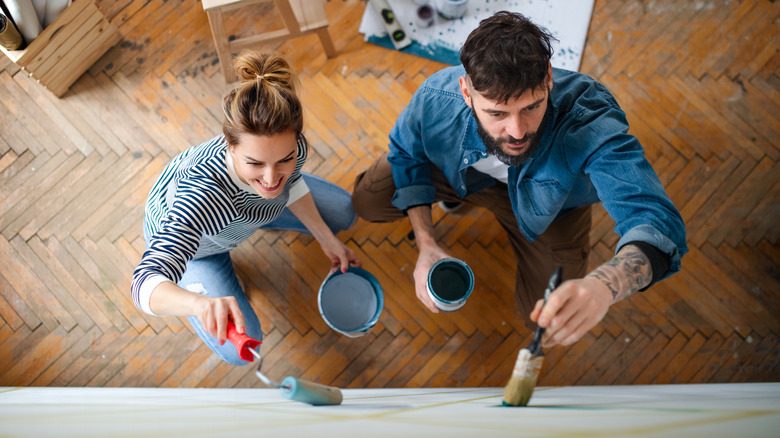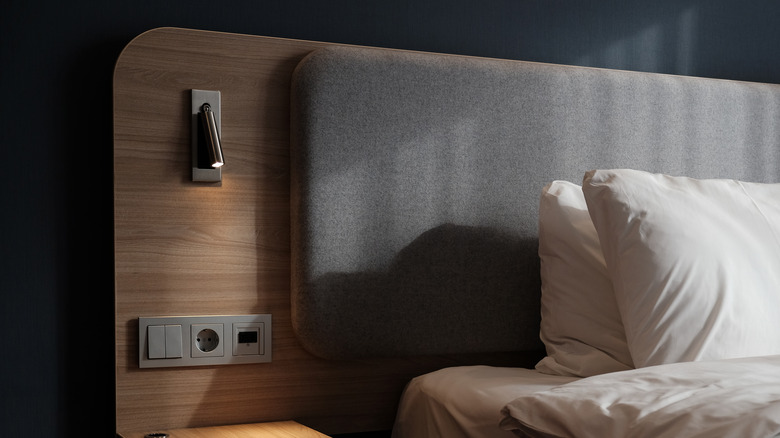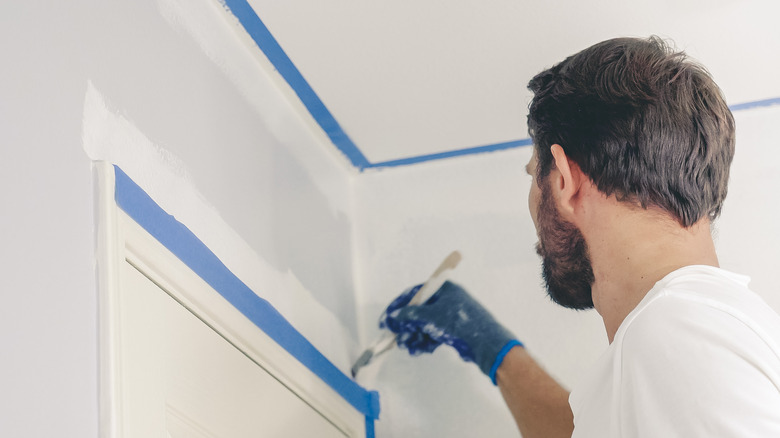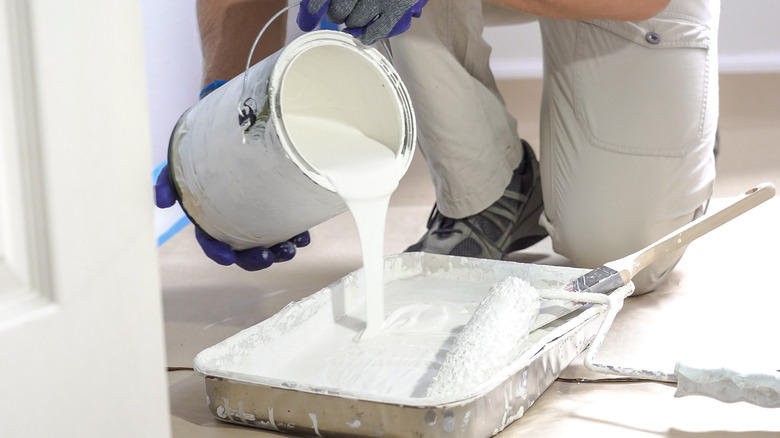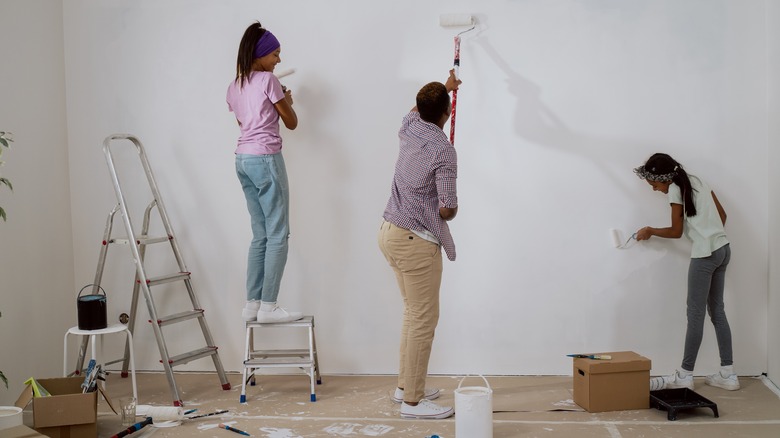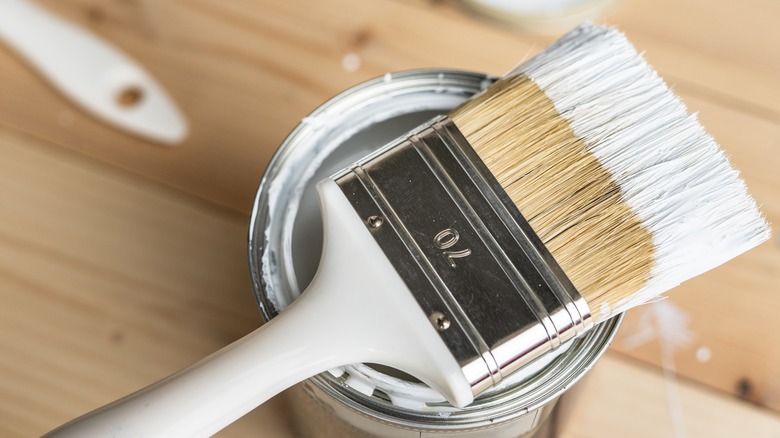5 Lies About Paint You Need To Stop Believing
According to Popular Mechanics, painting the interior of a home is the most popular DIY project that homeowners take on. It's also one of the easiest ways to give a room a fresh look. So if your space is feeling dull or you're bored with the style, a new layer of paint might be just what you're looking for.
Trimaco says winter is the best time of year to paint your home due to the reduced humidity. Less humidity means less drying time, which will help speed up the project. And, since it's also an indoor project, it won't matter what the weather looks like outside. However, since the winter is colder, opening a window while you paint is less of an option. The VOC vapors that are in the air as you paint can be harmful to you, kids, and pets within the home, so it's essential to find a way to properly ventilate the area (via ECOS Paint).
You can still open a window even if it's cold outside, but be sure to turn off your heater, so you don't waste energy. Even with ventilation, it's essential to keep kids and pets out of the area for at least three days, and anyone pregnant should also avoid the newly painted room. While it's important to follow the recommended safety precautions, there are certain beliefs about paint that just aren't true.
Dark colors will not always make a room look smaller
It's a common misconception that painting a room with dark colors will make it look smaller, which should be avoided. However, according to ProTek Painters, this isn't true. They suggest that dark accent colors in smaller rooms give the eye something interesting to look at. You can use it on a feature wall, within a stencil, or in wainscoting details. In larger rooms, using a darker color creates a cozy and comforting vibe. For example, a black accent wall in a bedroom with white bedding makes the room feel comfortable instead of bright and sterile. All-white spaces have been trendy for a while, but recently deep colors have been making appearances more often.
For the exterior of your home, ProTek Painters also say you don't have to stick with the traditional whites and blues that are so often used. Instead, darker colors will look fantastic and make your house stand out. Darker colors on a home's exterior also make it appear further from the road and, therefore, more private.
Painting before selling and always using white trim
If you're considering selling your home, you probably have a lot on your plate, between finding a new home, packing all your things, and finding new schools for the kids. Having to paint your home might be something that doesn't seem necessary. Walla Painting says that while it might seem insignificant, it's been proven repeatedly that homes sell faster and for better prices when they have a new coat of paint in trendy colors.
Another common misconception is that the trim in your home does not always have to be white, explains Protek Painters. It might be the popular way to go — however, there are other options. For example, white trim stands out against a painted wall, but you could paint it the same color as the wall to hide it or make it look taller. Alternatively, you could choose a contrasting color to make things more exciting and create the specific vibe you're trying to achieve.
High gloss paint is not more durable than other finishes
When you buy paint, the experts will ask what finish you would like the paint to have. This refers to the look and feels that the paint will have once it's dry (via Behr). There are several types, but the three main ones are high gloss, satin, and matte. High gloss is just like it sounds. It's glossy and has a smooth touch when you run your hand over it. Matte isn't shiny at all and feels soft when touched, whereas satin is a mixture of the two.
In the past, ProTek Painters says it was true that high-gloss paint was the most durable option and the best solution for painting bathrooms, kitchens, and kids' rooms. It was easier to clean and would handle bumps and regular cleanings better than other finishes — however, this isn't the case anymore. Thanks to advancing paint technology, high gloss, matte, and satin are typically scratch-resistant, mold and moisture-resistant and hold up well. This isn't always the case with cheaper paint, but high-quality paint will hold up well no matter which finish you choose. So it's more important to invest in good paint.
You don't always need two layers of paint
The number of coats of paint you need is determined by how well the area is prepped before painting and the quality of paint you have chosen. Sherwin-Williams says assuming you've thoroughly cleaned the site and applied a primer and high-quality paint is selected, you might only need one layer of paint. This is good news for your arms and your wallet!
Walla Painting states that not all paint is created equal. Therefore, going cheaper when choosing your paint will not always save you money in the long run. Cheap paint typically needs more layers to fully cover the wall and give the new color its full saturation. This means you'll have to buy more paint in the long run, which might be more expensive than just one layer of higher-quality paint. Additionally, lower-quality paint won't hold up over time and will need to be touched up or redone sooner than the higher-quality options. Which, again, costs more money and time.
It's not okay to skip using a primer
Primer is essential in preparing the walls to be painted. ProTek Painters think that this myth was started by professional painters knowing when it was okay to skip the primer. However, these specific instances are rare, and for a DIYers, it's better not to skip the primer. In addition, using a primer can save you time if you only have to paint one layer. And primer is typically cheaper than paint, so it will also save you money.
Applying a primer first gives the paint job a more professional look and helps the paint stick to the wall better. Anderson Painting says you'll also reduce the risk that the color you're painting over will change the tone of the new color you are applying. With all that being said, ProTek Painters says you might be able to skip priming if you are painting over the same color on walls assuming they have been adequately cleaned.
